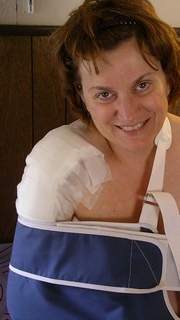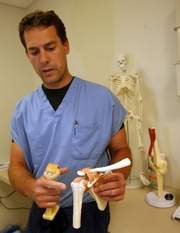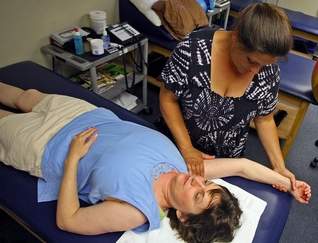 This article originally appeared in the August 3, 2010 (Morris County NJ) Daily Record and on the Daily Record web site.
This article originally appeared in the August 3, 2010 (Morris County NJ) Daily Record and on the Daily Record web site.
Repair the tear: Seniors at risk of torn rotator cuffs
By LORRAINE ASH • STAFF WRITER • August 3, 2010
Baby boomers, take note. We’re at risk for shoulder problems.
Last November, at age 50, I had 2 1/2-hour open surgery to repair a full-thickness tear of the subscapularis tendon of my rotator cuff. The subscapularis is one of four tendons of the rotator cuff that hold the shoulder joint in place and enable it to rotate in all directions.

Lorraine Ash — one day after open rotator cuff surgery. (Photo: Bill Ash)
When the subscapularis is sub par, the arm grows progressively weaker and doesn’t rotate inward until there’s just no reaching to the back. In the final month before my surgery, I could not even put my right hand in my back pocket.
Turns out, tears don’t happen just to baseball pitchers. The American Academy of Orthopaedic Surgeons reports the highest incidence of rotator cuff tears occur in people older than 60.
For the uninitiated, the shoulder rotates in so many directions because it’s not a closed joint. It depends on the rotator cuff — a system of four muscles and major tendons that attach muscle to bone — to hold it in place.
Why? Partially wear and tear, partially activity level, partially anatomy, specifically the shape of the acromion, a bone that covers the shoulder joint like a ceiling.
My surgeon, who performed the operation at Hackensack University Medical Center, retired soon afterward. So I sought out Dr. Andrew Willis of Tri-County Orthopedic & Sports Medicine in Cedar Knolls. He arthroscopically repairs some 350 rotator cuff tears a year at Atlantic Sports Health in Morristown, a specialized institute for sports injuries that is at Morristown Memorial Hospital. I asked Willis to talk about bone spurs, which was the culprit in my — and many — cases. This is where the acromion comes in.

Dr. Andrew Willis, a surgeon with Tri-County Orthopedic and Sports Medicine in Cedar Knolls, holds models of a shoulder that has been repaired, left, and one that is healthy at Atlantic Sports Health in Morristown, a specialized center for sports injuries. (Staff photo: Karen Mancinelli)
“Sometimes the unfortunate shape of the acromion itself is a problem,” Willis said. “There are natural shapes we believe you are born with — a flat-shaped one, a curve-shaped one and a hook-shaped one.”
A curve or hook, acting like a spur, can impinge on a rotator cuff tendon, thinning and eventually tearing it, sometimes even with everyday movements, as the decades go by. The doctor likened a tear to a pair of well-worn bluejeans that become fragile and eventually rip.
I needed open surgery because of the extent of my tear and because the particular tendon I tore is less commonly done arthroscopically due to potential risk of injury to the surrounding nerves and major blood vessels, according to Willis. Most people tear the supraspinatus tendon, which runs over the top of the ball of the shoulder joint, affects overhead movements and often causes pain.
After surgery I spent six weeks in a sling. But it was only five days after going under the knife that I started an 82-session regimen of physical therapy in which I gained back my mobility and strength.
It was no small feat because after surgery, I felt as if my shoulder had been cast in cement.
By New Year’s Day, out of the sling for two weeks, I could lift my right arm no more than two inches from my torso. I could not lift it enough to drive — and return to work — until March 1.
Why so slow? Because the trick is to get the shoulder moving and prevent muscle atrophy while not re-tearing the sewn-up tendons of the shoulder.
If I had to emphasize any point about physical therapy, it would be to choose a special place because it will become a second home. I decided on Achieve Sports Medicine & Rehab in Waldwick. Our goal was — and still is — lifting my arm over my head. I can do it now, but those final few degrees still aren’t comfortable.

Staff writer Lorraine Ash of the Daily Record completes her last physical therapy session following rotator cuff surgery. Physical therapist Carla DiFelice Sica works with her at Achieve Sports Medicine & Rehab in Waldwick. (Staff photo: Dawn Benko)
“Your collarbone has to flip to get those last degrees of flexion,” said Achieve therapist and co-owner Carla DiFelice Sica. “Everything in the shoulder girdle has to move properly in order to get that elevation.”
We’re getting there. DiFelice Sica believes one-on-one work with a therapist makes all the difference in rotator cuff recovery.
“There are still places that put people in a room with electric stimulation and heat, show them some exercises and send them home,” she said. “But rotator cuff tear recovery is a lot about soft tissue work and joint mobilization.”
It’s also about patience. Willis says it can take up to a full year before some rotator cuff surgery patients regain full function.
So here’s my point: It’s taking a long time for me to recover, but it also can take a long time — years — for all of us in the wear-and-tear population to get into this mess. Why not intervene before a partial tear becomes a full one and puts undue pressure on the surrounding tendons?
Seek prompt treatment. I acted in time.
When a patient waits so long that the muscles of the shoulder atrophy, Willis said, treatment options become less successful. We’re talking tendon transfers and possibly shoulder prostheses. No, thanks.
My out-of-pocket costs to date total $6,256, including reiki, acupuncture and, most recently, massage, which help a lot. But the benefits — being able to reach a faucet or lean back on my elbows — are priceless.
FOR MORE INFORMATION
ATLANTIC SPORTS HEALTH: treatment; Morristown; 973-971-6898, www.atlantichealth.org/morristown/our+services/sports+health/
CARLA DIFELICE SICA: physical therapy; Achieve Sports Medicine & Rehab, Waldwick; 201-493-7440
HENRY MCCANN: acupuncture; North Jersey Center for Acupuncture and Oriental Medicine, Madison; 973-660-0110; www.newjerseyacupuncture.com
THE URBAN MUSE SPA: massage; Denville; 973-627-3455; www.theurbanmuse.com/spa.html
DR. ANDREW WILLIS: treatment and surgery; Tri-County Orthopedics and Sports Medicine, Cedar Knolls; 973-538-2334; www.tri-countyortho.com
